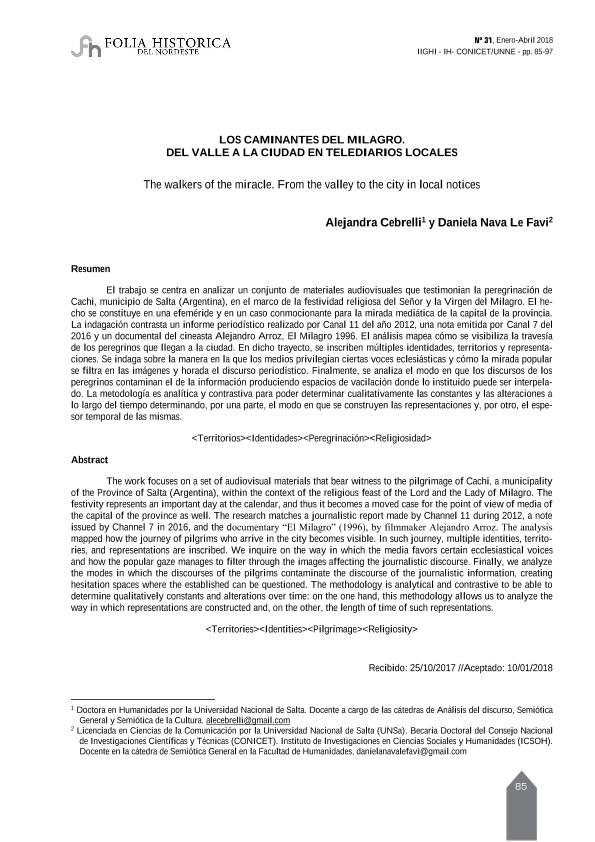Artículo
El trabajo se centra en analizar un conjunto de materiales audiovisuales que testimonian la peregrinación de Cachi, municipio de Salta (Argentina), en el marco de la festividad religiosa del Señor y la Virgen del Milagro. El hecho se constituye en una efeméride y en un caso conmocionante para la mirada mediática de la capital de la provincia. La indagación contrasta un informe periodístico realizado por Canal 11 del año 2012, una nota emitida por Canal 7 del 2016 y un documental del cineasta Alejandro Arroz, El Milagro 1996. El análisis mapea cómo se visibiliza la travesía de los peregrinos que llegan a la ciudad. En dicho trayecto, se inscriben múltiples identidades, territorios y representaciones. Se indaga sobre la manera en la que los medios privilegian ciertas voces eclesiásticas y cómo la mirada popular se filtra en las imágenes y horada el discurso periodístico. Finalmente, se analiza el modo en que los discursos de los peregrinos contaminan el de la información produciendo espacios de vacilación donde lo instituido puede ser interpelado. La metodología es analítica y contrastiva para poder determinar cualitativamente las constantes y las alteraciones a lo largo del tiempo determinando, por una parte, el modo en que se construyen las representaciones y, por otro, el espesor temporal de las mismas. The work focuses on a set of audiovisual materials that bear witness to the pilgrimage of Cachi, a municipality of the Province of Salta (Argentina), within the context of the religious feast of the Lord and the Lady of Milagro. The festivity represents an important day at the calendar, and thus it becomes a moved case for the point of view of media of the capital of the province as well. The research matches a journalistic report made by Channel 11 during 2012, a note issued by Channel 7 in 2016, and the documentary “El Milagro” (1996), by filmmaker Alejandro Arroz. The analysis mapped how the journey of pilgrims who arrive in the city becomes visible. In such journey, multiple identities, territories, and representations are inscribed. We inquire on the way in which the media favors certain ecclesiastical voices and how the popular gaze manages to filter through the images affecting the journalistic discourse. Finally, we analyze the modes in which the discourses of the pilgrims contaminate the discourse of the journalistic information, creating hesitation spaces where the established can be questioned. The methodology is analytical and contrastive to be able to determine qualitatively constants and alterations over time: on the one hand, this methodology allows us to analyze the way in which representations are constructed and, on the other, the length of time of such representations.
Los caminantes del milagro : del valle a la ciudad en telediarios locales
Título:
The walkers of the miracle. From the valley to the city in local notices
Fecha de publicación:
06/2018
Editorial:
Universidad Nacional del Nordeste. Instituto de Investigaciones Geohistóricas
Revista:
Folia Histórica del Nordeste
ISSN:
0325-8238
e-ISSN:
2525-1627
Idioma:
Español
Tipo de recurso:
Artículo publicado
Clasificación temática:
Resumen
Palabras clave:
TERRITORIOS
,
IDENTIDADES
,
PEREGRINACION
,
RELIGIOSIDAD
Archivos asociados
Licencia
Identificadores
Colecciones
Articulos(ICSOH)
Articulos de INST.DE INVEST. EN CS. SOC. Y HUMANIDADES
Articulos de INST.DE INVEST. EN CS. SOC. Y HUMANIDADES
Citación
Cebrelli, Alejandra Lía Julia; Nava Le Favi, Daniela Andrea; Los caminantes del milagro : del valle a la ciudad en telediarios locales; Universidad Nacional del Nordeste. Instituto de Investigaciones Geohistóricas; Folia Histórica del Nordeste; 31; 6-2018; 85-97
Compartir
Altmétricas




